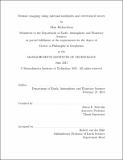| dc.contributor.advisor | Alison E. Malcolm. | en_US |
| dc.contributor.author | Richardson, Alan, Ph. D. Massachusetts Institute of Technology | en_US |
| dc.contributor.other | Massachusetts Institute of Technology. Department of Earth, Atmospheric, and Planetary Sciences. | en_US |
| dc.date.accessioned | 2015-09-17T19:03:48Z | |
| dc.date.available | 2015-09-17T19:03:48Z | |
| dc.date.copyright | 2015 | en_US |
| dc.date.issued | 2015 | en_US |
| dc.identifier.uri | http://hdl.handle.net/1721.1/98671 | |
| dc.description | Thesis: Ph. D., Massachusetts Institute of Technology, Department of Earth, Atmospheric, and Planetary Sciences, 2015. | en_US |
| dc.description | Cataloged from PDF version of thesis. | en_US |
| dc.description | Includes bibliographical references (pages 199-205). | en_US |
| dc.description.abstract | Incorporating overturned waves and multiples in seismic imaging is one of the most plausible means by which imaging results might be improved, particularly in regions of complex subsurface structure such as salt bodies. Existing migration methods, such as Reverse Time Migration, are usually designed to image solely with primaries, and so do not make full use of energy propagating along other wave paths. In this thesis I describe several modifications to existing seismic migration algorithms to enable more effective exploitation of the information contained in these arrivals to improve images of subsurface structure. This is achieved by extending a previously proposed modification of one-way migration so that imaging with overturned waves is possible, in addition to multiples and regular primaries. The benefit of using this extension is displayed with a simple box model and the BP model. In the latter, the proposed method is able to image the underside of a salt overhang when even RTM fails, although substantial artifacts are also present. Progressing to the two-way wave equation, I explain three new ways in which a wavefield may be separated by wave propagation direction, and use these in proposed modifications to the RTM algorithm. With these modifications, overturned waves and multiples can be used more effectively, as they no longer risk subtracting from the image contributions of primaries, their amplitude is boosted to produce greater relative amplitude accuracy, and artifacts usually associated with the use of these arrivals are attenuated. The modifications also provide two means of expressing image uncertainty. Among the results I show are a demonstration of the superior image obtained using the proposed method compared to the source-normalized imaging condition, and an improved image of a salt body in the SEAM model. Finally, I describe another modification to RTM that further reduces artifacts associated with the inclusion of multiples, exhibiting its effectiveness with simple layer models, and on a portion of the SEAM model. | en_US |
| dc.description.statementofresponsibility | by Alan Richardson. | en_US |
| dc.format.extent | 205 pages | en_US |
| dc.language.iso | eng | en_US |
| dc.publisher | Massachusetts Institute of Technology | en_US |
| dc.rights | M.I.T. theses are protected by copyright. They may be viewed from this source for any purpose, but reproduction or distribution in any format is prohibited without written permission. See provided URL for inquiries about permission. | en_US |
| dc.rights.uri | http://dspace.mit.edu/handle/1721.1/7582 | en_US |
| dc.subject | Earth, Atmospheric, and Planetary Sciences. | en_US |
| dc.title | Seismic imaging using internal multiples and overturned waves | en_US |
| dc.type | Thesis | en_US |
| dc.description.degree | Ph. D. | en_US |
| dc.contributor.department | Massachusetts Institute of Technology. Department of Earth, Atmospheric, and Planetary Sciences | |
| dc.identifier.oclc | 920682139 | en_US |
